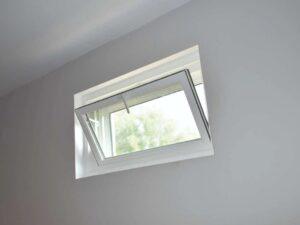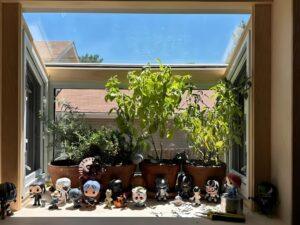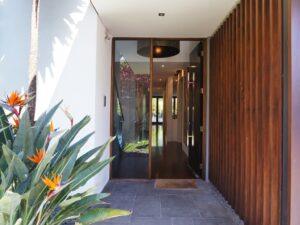A garden window does more than improve your view—it gives you light, fresh air, and a little extra space you’ll actually use. In this guide, you’ll learn exactly what garden windows are, where they work best in your home, and what to think about before you start the installation.
Whether you’re looking to grow herbs indoors or just want more sunlight in your kitchen, this will help you decide if it’s the right upgrade for you.
What Is a Garden Window?
A garden window is a three-dimensional window unit that extends outward from your home’s exterior wall. It’s similar to a small bay window but designed specifically to serve as a mini-greenhouse.
Notable differences from conventional windows include the following:
- It protrudes 12 to 24 inches outward, creating a shelf space.
- It has glass on four sides: the front, two angled sides, and the top.
- Some include casement-style side panels for ventilation.
Garden windows are usually installed above kitchen sinks or counters, where you can place herbs, small plants, or decorative items. They’re functional, attractive, and bring more sunlight into your home.
Why Homeowners Choose Garden Windows
Garden windows come with several practical benefits that go beyond appearance. From adding natural light to creating space for plants or storage, here’s why many homeowners see them as a smart upgrade.
1. More Natural Light
Garden windows are designed with angled glass panels that let sunlight in from multiple directions. This makes a noticeable difference in rooms that usually feel dim or rely heavily on overhead lighting.
If your kitchen or laundry room doesn’t get much natural light, a garden window can brighten the space throughout the day without the need for extra fixtures.
2. Better Ventilation
Many garden windows include side panels that open outward. These vents create natural airflow, which helps cool the room and release moisture or cooking odors.
In kitchens, this feature is especially useful when prepping food or running appliances. It also benefits your plants, giving them the fresh air they need to thrive indoors.
3. Indoor Garden or Storage Space
The shelf area built into a garden window gives you extra space you can actually use. Whether you grow herbs like basil or parsley, or simply display a few succulents, the setup keeps plants within reach and in full view.
You can also use it for lightweight storage—cookbooks, small jars, or decorative bowls all fit well and stay easily accessible.
4. Enhanced Outdoor Views
Because the window extends outward, it gives you a wider, more open view than a flat window. This makes small rooms feel bigger and more connected to the outside world.
You get a clearer look at your yard, garden, or patio, whether you’re cooking, cleaning, or just enjoying your space.
5. Architectural Detail
A garden window changes how a room looks and feels, both inside and out. From the curb, it adds depth and character to your home’s exterior. Inside, it becomes a functional focal point that’s more than just a window.
These design improvements can add real value, especially if you plan to sell your home in the future.
Best Places to Install Garden Windows
Not every room or wall is suitable for a garden window. Choose locations that offer the right balance of light, visibility, and convenience.
✔ Kitchen Sink
The kitchen sink is the most popular location for a garden window—and for good reason. It brings in natural light right where you prepare meals, wash dishes, and spend time throughout the day.
The built-in shelf offers a perfect spot for small potted herbs, adding freshness and function to your kitchen.
It’s also one of the easiest places to care for plants, since it’s within arm’s reach and close to a water source. Most kitchen sink areas already have ventilation or an existing window, which makes window installation more straightforward and cost-effective.
✔ Laundry Room
A garden window can transform a basic laundry room into a more pleasant space. The extra sunlight helps brighten a part of the home that often feels closed off or forgotten.
The added shelf also serves a practical purpose: holding detergents, dryer sheets, or even a few low-maintenance plants.
Natural light makes the room feel larger, and the view outside adds a little relief from the task-focused environment. It’s a simple way to make laundry less of a chore while adding warmth to the space.
✔ Breakfast Nook or Dining Area
In a breakfast nook or small dining space, a garden window can improve the entire feel of the room. It lets in gentle morning or midday light, creating a relaxed and inviting spot to enjoy meals.
If your eating area is compact, the window adds openness without changing the room’s layout. It also allows for airflow during warmer months and gives you a place to display small décor items, plants, or seasonal accents that tie into your home’s style.
Locations to Avoid
Some spots in your home may not be ideal for a garden window. Here’s where installation can cause more trouble than benefit:
- Behind large appliances or furniture: If the window is blocked, it becomes hard to access for cleaning, watering plants, or opening the vents.
- Facing a neighbor’s window or close property line: This can create privacy concerns and uncomfortable sightlines for both households.
- South-facing walls in hot climates: Without UV-blocking glass, too much direct sunlight can lead to overheating and increase cooling costs.
- Areas without structural support: Installing a window in a wall not built for the added weight may require expensive framing or reinforcement.
- Rooms where moisture is a concern but ventilation is limited: Poor airflow can cause condensation to build up, which may damage surrounding materials over time.
Before you choose a location, think about how the space is used and whether the window will remain practical day to day.
Materials and Customization Options
Garden windows come in a variety of materials and configurations. Each option impacts cost, maintenance, and long-term durability.
Frame Materials
- Vinyl: Vinyl is the most popular choice because it offers energy efficiency, low maintenance, and affordability.
- Wood: Wood provides a warm, natural look but requires regular sealing and painting to stay in good condition.
- Fiberglass: Fiberglass is strong, stable in extreme weather, and long-lasting, though it tends to be more expensive.
- Aluminum: Aluminum is lightweight and durable, but it can transfer heat unless it includes a thermal break.
Glass Options
- Double-pane or Triple-pane: These glass types provide insulation, helping to reduce heat transfer and improve energy efficiency.
- Low-E Coating: Low-E coating reflects UV rays, which helps lower indoor temperatures and prevents fabric and surface fading.
- Tempered Glass: Tempered glass is more resistant to breaking, making it a safer option for high-impact areas.
Features and Add-ons
- Operable Side Vents: These vents can be opened to allow airflow, improving ventilation in kitchens, laundry rooms, or small spaces.
- Shelves: Built-in glass or wood shelves provide extra space for displaying plants, storing kitchen items, or adding decorative touches.
- Custom Grilles: Grilles can be customized to match the design of your existing windows for a consistent appearance.
- Interior Color/Finish: Garden windows are available in finishes like white, tan, or woodgrain to blend with your interior style.
Are Garden Windows Energy Efficient?
They can be, as long as you choose the right materials and features. Energy efficiency depends on:
- Insulated Glass: Double or triple panes reduce heat transfer
- Tight Seals: Prevent drafts, condensation, and moisture damage
- Frame Construction: Vinyl and fiberglass insulate better than aluminum
- Glass Treatments: Low-E coatings reduce sun’s heat while letting in light
Warning: Poorly installed or single-pane units can lose heat in winter and allow excess heat in summer. That can cancel out the benefits.
If energy savings matter to you, check for ENERGY STAR® certified units and ask about the U-factor and SHGC (Solar Heat Gain Coefficient) ratings before buying.
Pros of Garden Windows
- Brings in more light and airflow
- Adds usable indoor shelf space
- Boosts resale appeal in most markets
- Customizable to your home’s design
- Great for indoor gardening or small displays
Cons of Garden Windows
- Higher upfront cost than flat windows
- Needs cleaning on multiple glass surfaces
- May require structural changes to install
- Less privacy than traditional windows
- Some models may protrude into walkways or exterior paths
Ask Yourself
Is the added light, space, and visibility worth the cost and upkeep? If the answer is yes, then a garden window is a smart upgrade.
Is a Garden Window Right for Your Home?
This type of window is worth considering if:
- You want to grow herbs, succulents, or plants indoors
- Your kitchen or laundry room feels dark or boxed in
- You like opening up the view to your yard or garden
- You’re planning a kitchen remodel and want more light without removing walls
It may not be the right choice if:
- You’re on a tight renovation budget
- You need full privacy in the room
- Your wall space is blocked or hard to access
If you’re still unsure, consult with a window specialist who can evaluate your home’s layout and needs.
Why Homeowners Choose Ameritech Windows
At Ameritech Windows, we’ve helped thousands of Colorado homeowners upgrade their spaces with energy-efficient, well-crafted garden windows.
We offer:
- Custom window sizing and design
- High-performance vinyl and glass
- Precision installation from trained technicians
- Clear pricing with no hidden fees
You get a window that lasts, and a team that stands behind it. Want to learn more? Call now or request a free in-home consultation.










